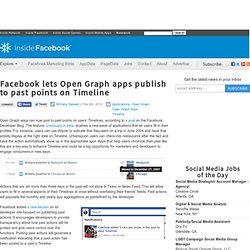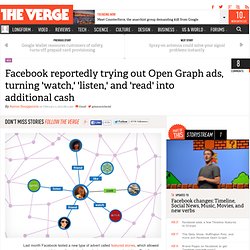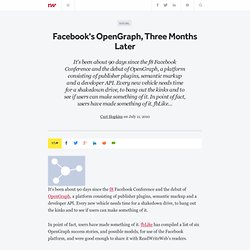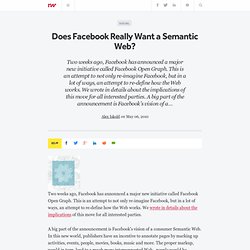

Facebook lets Open Graph apps publish to past points on Timeline. Facebook lets Open Graph apps publish to past points on Timeline Open Graph apps can now post to past points on users’ Timelines, according to a post on the Facebook Developer Blog.

The feature, previously in beta, enables a new wave of applications that let users fill in their profiles. For instance, users can use Wipolo to indicate that they went on a trip in June 2004 and have that activity display at the right date on Timeline. Urbanspoon users can check into restaurants after the fact and have the action automatically show up in the appropriate spot. Apps that help users chronicle their past like this are a key way to enhance Timeline and could be a big opportunity for marketers and developers to engage consumers in new ways. Actions that are set more than three days in the past will not show in Ticker or News Feed. Facebook reportedly trying out Open Graph ads, turning 'watch,' 'listen,' and 'read' into additional cash.
Last month Facebook tested a new type of advert called featured stories, which allowed companies to publish your likes in the form of ads on your news feed.

60 apps launch with Facebook auto-share. Five things to know before using Facebook Timeline apps. Facebook finally unveiled a host of apps this evening that, coupled with Timeline profiles, will bring an entirely new experience to its users.

Initially announced at the F8 conference in San Francisco last September, Timeline apps (also known as Open Graph apps) allow brands to add real-world interactions to their applications. Spotify was one of the first companies to release a Timeline app, letting users share what they are listening to with their Facebook friends in real time. For example as a user listens to a song on Spotify, the activity appears as, "Jane Doe is listening to July by Youth Lagoon on Spotify" on Facebook.
With tonight's announcement of more than 60 new Timeline apps, users can expect to see more actions beyond listening, like "reading," "watching," "cooking," and "running". But before you add these attractive new apps, consider the way Open Graph works and how exactly it will affect your Facebook experience. 1. 2. 3. 4. Tout savoir sur l'Open Graph. Comment utiliser le Social Graph de Facebook. C’est à la conférence Facebook F8, au printemps 2007, que Mark Zuckerberg a introduit la notion de social graph.

Le sujet a fait couler beaucoup d’encre a coulé mais, curieusement, il ne me semble pas que quiconque ait fait la simple démarche d’aller compulser les instructions techniques de Facebook permettant de l’exploiter. Même si tout est en anglais et que cela s’adresse aux développeurs. Il n’en reste pas moins que c’est là que tout se joue. Explorons la chose en détail : Une API Le document dont je vais donc traiter s’intitule Graph API overview : c’est un résumé des possibilités offertes par l’API du social graph. L'Open Graph de Facebook - Agence Up 2 social.
The Open Graph Protocol Design Decisions. Why Facebook's Open Graph? By now, we have all started to see the power of Facebook’s Open Graph take shape in the online community both on and off of Facebook.

By enhancing digital experiences with social and personalized information, Facebook has helped shape the direction for the web’s future. Facebook's OpenGraph, Three Months Later. It's been about 90 days since the f8 Facebook Conference and the debut of OpenGraph, a platform consisting of publisher plugins, semantic markup and a developer API.

Every new vehicle needs time for a shakedown drive, to bang out the kinks and to see if users can make something of it. In point of fact, users have made something of it. fbLike has compiled a list of six OpenGraph success stories, and possible models, for use of the Facebook platform, and were good enough to share it with ReadWriteWeb's readers. Not shockingly, they've included themselves. But they make a pretty good case for inclusion. How to Choose Open Graph Tags That Maximize the Value of Your Like Buttons. The following is an excerpt from the Facebook Marketing Bible, the comprehensive guide to marketing your company, app, brand, or website using Facebook.

The full version of this article, available through a Facebook Marketing Bible subscription, includes a breakdown of the significance of every Open Graph tag option, strategies for adding Like buttons with feed publishing capabilities to news articles and other digital content that typically aren’t allowed to publish to the feed, and instructions for implementing, testing, and editing Open Graph tags. By adding Open Graph <meta> tags to the <HEAD> of your website, you can classify and describe the content you attach Like buttons to. This allows Facebook to present the right image, category, and other information about your site when Likes of your content appear in news feed stories and user profiles. The type of tags you choose also define the functionality of your Like buttons. To generate Open Graph tags: Comprendre le Social Graph de Facebook. Après avoir introduit les enjeux du référencement sur Facebook ainsi que les critères de pertinence du Social Rank, je te propose aujourd’hui un billet permettant de mieux comprendre (en tout cas je l’espère) le Social Graph de Facebook.

Mais le Social Graph en gros c’est quoi ? Popularisé par Mark Zuckerberg (fondateur de Facebook), le « Social Graph » désigne le réseau de connexions et de relations entre les gens et les objets du monde réel (les produits, les lieux, les entreprises, les articles d’un site web …) A quoi sert le Social Graph ? Cette modélisation et l’enregistrement des données via Facebook permettent la diffusion et le filtrage efficace de l’information pouvant ainsi améliorer le classement des ressources sur le web via un système de recommandations sociales.
Un changement important dans le monde de la rercherche sur le Web ? Voici le type d’affichage que vous pourrez voir apparaitre dans les résultats de recherche de Bing (aux US seulement pour l’instant) inShare33. Open Graph protocol. Does Facebook Really Want a Semantic Web? Two weeks ago, Facebook has announced a major new initiative called Facebook Open Graph.

This is an attempt to not only re-imagine Facebook, but in a lot of ways, an attempt to re-define how the Web works. We wrote in details about the implications of this move for all interested parties. A big part of the announcement is Facebook's vision of a consumer Semantic Web. In this new world, publishers have an incentive to annotate pages by marking up activities, events, people, movies, books, music and more. The proper markup, would in turn, lead to a much more interconnected Web - people would be connected with each other across websites and around the things they are interested in. Directionally, this vision is both correct and important. "Instead, it appears that semantics is an afterthought in the race to capture user identity and information, in exchange for sending publishers the traffic. " Concerns with Open Graph Protocol Both of these shortcomings are easy to correct.